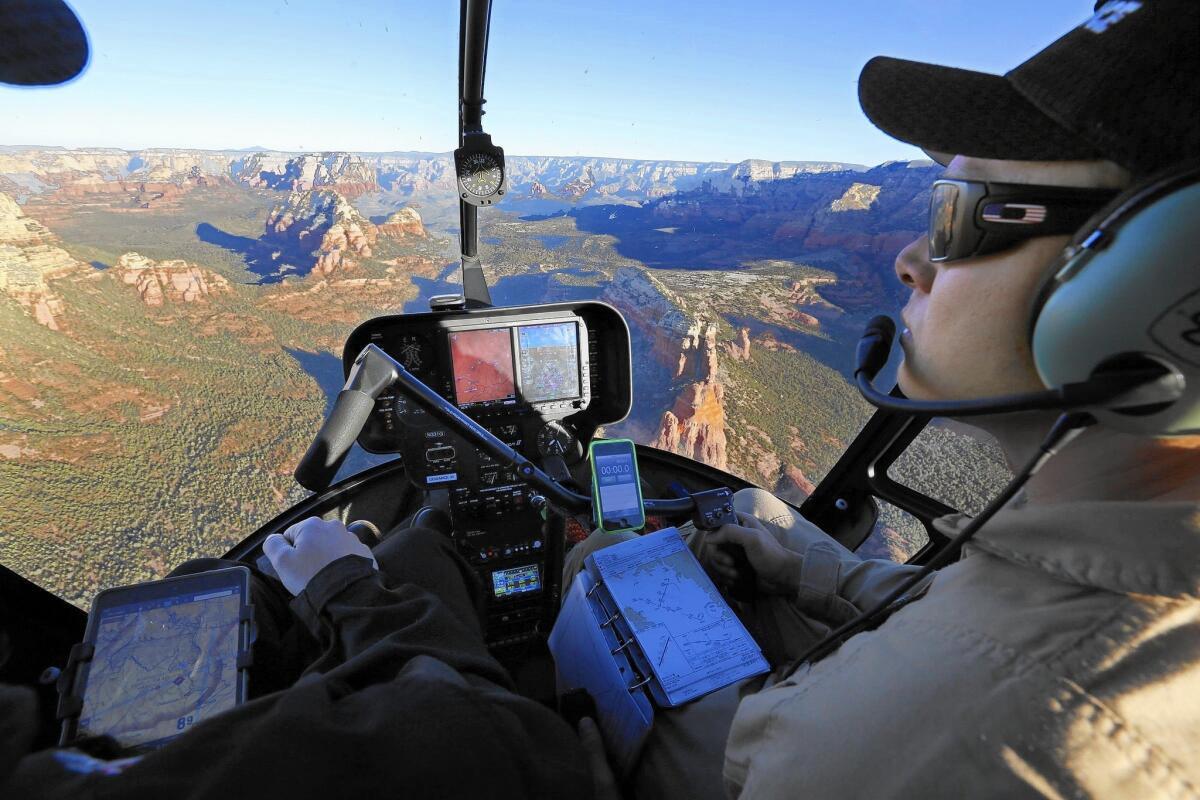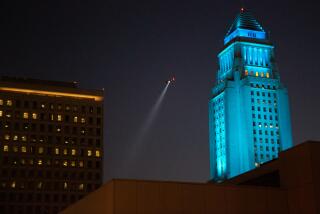U.S. taxpayers stuck with the tab as helicopter flight schools exploit GI Bill loophole

- Share via
For some flight schools that train helicopter pilots, the GI Bill that took effect in 2009 was a windfall the government never intended.
Helicopter schools had been struggling financially, and the bill excluded them from direct funding. But after finding a loophole in the law that allows them to train military veterans completely at government expense, with no cap on what they can charge, the schools rapidly expanded. They now collect tens of millions a year in taxpayer dollars.
For two years of training to become a pilot, the government often pays more than $250,000, over twice the amount non-veterans pay at many schools, The Times has found from interviews, government documents, price lists and flight school contracts.
At one flight company — Utah-based Upper Limit Aviation — records show 12 veterans whose training had cost the government more than $500,000 each.
Upper Limit’s fees make it the costliest education of any type funded by the GI Bill. The company will collect roughly $36 million this year from the government, based on its current enrollment and estimates it submitted to the state of Utah.
Sean Reid, who owns the company with his mother, Lois Reid, confirmed that figure.
He said that when helicopter training businesses discovered there was no limit on how much the government would pay, they began competing with one another to attract veterans. Offering costly training on sophisticated helicopters was a powerful recruiting tool that has also given students an advantage in the job market, he said.
“Because there was no cap, we started to one-up each other,” Reid said. “You kind of end up with an arms race.”
The company and others funded largely by the GI Bill train pilots who eventually could fly for oil companies, medical transport services, tour operators and other industries.
The Post-9/11 GI Bill, which pays for recent veterans to go to college, had blocked flight training businesses from direct funding because Congress did not want to pay for schools not offering educational degrees. But the law placed no limit on payments for veterans pursuing degrees at public colleges and universities.
By working as contractors for public institutions, the flight companies could turn on a revenue stream unprecedented in their industry. The public schools, most of them community colleges, welcomed the opportunity to enroll veterans and offer them degrees in aviation.
The colleges oversee the flight programs. They bill the government, collect the money, keep some for tuition and pass the rest to the flight companies.
Officials at the U.S. Department of Veterans Affairs, which administers the GI Bill, were unable to provide the total number of helicopter students across the country or their cost.
The Times identified 15 helicopter training businesses in 10 states that are tapping into the GI Bill and focused on two of the largest and most expensive: Upper Limit, headquartered in Salt Lake City, and Guidance Aviation, in Prescott, Ariz.
Before the injection of government money, the flight training industry was suffering in the global economic crisis. Then, as now, few private students could afford helicopter lessons, and it was difficult to get loans. But after the GI Bill took effect, the programs began heavily recruiting veterans, whose tuition and fees are paid in full by the government. Enrollments soared.
Today, with a total of roughly 430 veterans enrolled, the two companies are rapidly expanding their helicopter fleets, adding turbine models that allow them to bill more for training.
“I would have three helicopters if it weren’t for the Post-9/11 GI Bill,” said John Stonecipher, the owner of Guidance Aviation, which has 23 helicopters and a staff of 108 training nearly 200 students — most of them veterans — in Prescott and a second location in Baton Rouge, La.
Student pilots practice landing on a houseboat Stonecipher keeps at Lake Powell.
Stonecipher said the GI Bill is crucial to meet the demand for helicopter pilots. The training his company provides — including time in turbine helicopters — helps veterans land the best jobs available, he said.
He acknowledged that the bill has been an enormous boost to his business, which he said had revenues of more than $15 million last year.
At the same time, he said, the company has had to take on more than $12 million in debt in order to buy enough helicopters to meet the growing demand for training.
“There’s a tremendous amount of risk associated with this,” he said.
In 2013, the U.S. Small Business Administration named Stonecipher “small-businessman of the year” for his success and commitment to veterans.
Inside the VA, staff members are angry at what they see as government waste. With an amendment that took effect in 2011, Congress extended GI Bill funding to vocational programs but capped direct payments to proprietary flight schools at $10,000 a year per student.
But the loophole remained in place.
As long as the money flows through a public institution, there is no limit on what the VA will pay for flight training, Robert Worley, head of education services for the agency, said in an interview.
“We have really no option other than to pay,” he said.
“The VA is concerned about the cost of these flight programs,” he said. “We don’t think it was the intent of Congress to pay that kind of money.”
The main leverage the government has to control program costs is a regulation requiring that non-veterans make up at least 15% of students in VA-funded programs. The intent is to prevent colleges from charging the VA more than non-veterans are willing to pay.
Given their high price, the flight programs have struggled to attract enough non-veterans to satisfy the so-called 85-15 rule. But the regulation has been interpreted by the VA in ways that favor the schools.
For example, Yavapai College — the two-year school in Prescott that contracts with Guidance — has been allowed to meet the 15% threshold by including non-veterans studying airport management or other aspects of aviation that don’t require the costly flight time.
Like the flight students, they are aviation technology majors, a degree that was created to help satisfy the rule, said John Morgan, who oversees the program at the college.
Morgan said the regulation is unfair to veterans who have been denied enrollment because the program did not have enough other students.
A former Yavapai employee has alleged in a federal whistleblower lawsuit that the college has also counted Guidance employees — and even Stonecipher’s wife — in its tally of private students.
Stonecipher said that ground school classes toward an aviation degree at Yavapai were a benefit for his employees. His wife had wanted to learn to fly but found she couldn’t because of back problems, he said.
Yavapai officials declined to comment on the case, which is pending.
The charges for veterans are high because they often train in more expensive helicopters than other students can afford. Most schools charge about $300 an hour for students to fly a two-seat piston-powered Robinson R-22. The four-seat R-44 goes for about $600 an hour.
At Upper Limit, which has about 230 veterans, students can train in a turbine-powered Eurocopter Astar for $1,800 an hour. An elective offered last year was taught in a Bell 205, which cost the VA $3,500 an hour.
“We know there is sticker shock on the price of training,” said Reid, the owner.
He said all students are free to chose which models they fly and that the company bases its fees on hourly operating rates that are standard in the industry.
“We’ve got a lot of people jobs,” he said. “They’re not committing suicide. They’re not homeless. They’re using the benefits they’ve earned.”
Sean Heiner, flight program director at Southern Utah University — which contracts with Upper Limit — said the price was “not outrageous” when compared with military spending on pilot training.
Stonecipher said he added four Robinson R-66 turbine helicopters to his fleet to remain competitive with Upper Limit in recruiting veterans. In a single semester in 2013, four veterans at Guidance each racked up flight fees of $92,411 in the R-66, according to interviews and records from Yavapai College.
Private students have difficulty affording the training even in the basic R-22.
“The guys who have a ton of money on the line work really hard,” said David Franklin, who took out private loans and a credit line on his family’s plumbing business in Prescott to pay for his training at Guidance, which cost $120,000. “I tried to keep things going the cheapest way possible by flying the cheapest helicopters.”
The VA does not make graduation rates available, but records from Yavapai and data provided by Guidance show that about 60% of veterans who start the program eventually drop out.
In a group of 20 veterans who started at Upper Limit in January of 2012, Matt Kawamura was one of only six to compete pilot training, he said.
Kawamura learned about Upper Limit when recruiters from the company came to his base in Twentynine Palms as he was preparing to leave the Marine Corps. He enrolled at Salt Lake Community College, where Upper Limit has a contract, and transferred to Southern Utah University in Cedar City in 2013 when the company started its partnership there.
“It’s fantastic the VA is supporting this kind of opportunity for us,” said Kawamura, 26.
Total payments to the colleges on his behalf have exceeded $600,000, including about $190,000 for three electives that provided a total of 79 hours in the air, according to Kawamura.
After he earned his credentials, Kawamura was hired by Upper Limit for $14.50 an hour as a flight instructor, the only job most new pilots can hope for.
It’s an odd arrangement — making the least experienced pilots the teachers — but it has long been the standard way that new pilots accumulate flight time that opens the door to more lucrative jobs.
Most pilots finish their training with a commercial license, instructor credentials and 200 to 300 hours of experience in the air. It usually takes two years of teaching to hit 1,000 hours, which is the experience level most tour companies and their insurers require. Oil company contractors and air ambulances — two of the biggest employers of helicopter pilots — often mandate 2,000 hours.
By this February, Kawamura had more than 1,200 hours. He said he is confident that he will soon be flying for a police department, tour company or television news operation. He expects to earn between $40,000 and $70,000 a year.
Nobody tracks how many people work as helicopter pilots, but the number of non-military helicopters in service has been growing. The U.S. total last year was 9,146, up 17% from 2007, according to the research firm Jetnet.
Online job posts show that companies are hiring pilots with the requisite hours.
But it is unclear how long that will last as more veterans enter the job market. Their competition includes pilots who received their training in the military. A total of 6,880 helicopter pilots have left the Army and Navy since 2007.
Pilots just out of flight school face the biggest challenge. They are dependent on those schools for jobs as flight instructors — and in turn on an growing influx of veterans using the GI Bill.
For now, the bill continues to drive sharp growth in the training business.
Guidance said that 76% of its new graduates land jobs, most of them as Guidance instructors, and that an additional 12% have remained in school, often to pursue an airplane pilot license under the GI Bill.
Upper Limit says the overwhelming majority of its graduates find jobs as instructors.
The company hopes to create more instructor jobs by establishing new programs with colleges in Kentucky, Tennessee and California.
Other companies launching new programs are also hiring instructors.
If the expansion slows, however, so will hiring, making it difficult for new graduates to advance.
There are hints of a bottleneck.
Joel Skaggs, a 37-year-old former Marine, earned his certification as a flight instructor last August from Guidance.
He worked as a dispatcher for the company for the next seven months until an instructor spot opened for him last week.
“It’s all about timing,” said Skaggs, whose training cost more than $305,000.
Justin Loftis, who graduated from the same program in 2012, searched for an instructor position for a year before giving up.
“I interviewed at a lot of places,” he said. “It was always, ‘We like you, but this other guy has a few hours more than you.’”
Today, at 31, he works in a gold mine in northern Nevada repairing hydraulic machinery. At least his Navy experience as a mechanic qualified him for something, he said.
“If you don’t have anything else to fall back on, it’s kind of depressing,” he said.
More to Read
Sign up for Essential California
The most important California stories and recommendations in your inbox every morning.
You may occasionally receive promotional content from the Los Angeles Times.











